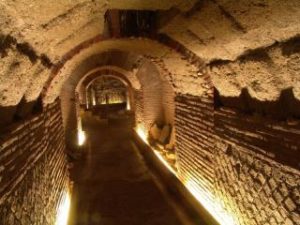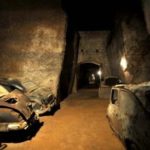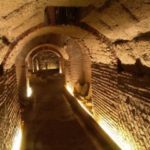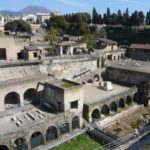A forty feet deep beneath the shouting and characteristic streets of the historical center of Naples, is a world apart, for a long unexplored, isolated in his millennial quiet yet closely connected with the city. And ‘the womb of Naples, from which she herself was born. Visiting it means taking a journey through time along two thousand and four hundred years.
The tour includes three courses for a period of about 2 hours.
1) greek-Roman Aqueduct
down 136 steps, low and comfortable, we arrive at a depth of approx. 40 m, where we will visit some of the cavity excavated in tuff Greek era (fourth century BC.) Exploited as tanks for water supply in our city for about twenty-three centuries. The rooms are all spacious and illuminated crossed, except for a short stretch where the route is, however, optional, but full of charm because it is enlightened by the light of candles, also the walking surface is smooth and straight. The visit has a duration of approximately one hour.
2) Visit to the ruins of the Roman theater incorporated
Visit a part of the Roman Theatre in Naples, incorporated in the fifteenth century, from the homes that exist today in Via Anticaglia, Vico Cinquesanti and Via S. Paul. It will come in a typically Neapolitan, commonly called “low”, because it is located on the street level of the city, and already there we will find ourselves in the Roman theater. Just move a bed and open a hatch to access in other environments where Nero had his own private dressing room, whenever he was to stage his shows in Naples. The tour lasts about 20 minutes.
3) Visit the Summa Cavea
We have recently expanded with a new route discovery. In fact, in an old carpentry reappear here another piece of theater in which ‘was a permanent exhibition with thirty scarabattoli old, dark wood to keep the nativity scene nativity scenes and popular. All around, opus reticulatum and latericium. We soffit-summa cavea of ??the theater greek – roman Cinquesanti alley behind Piazza San Gaetano, remote agora of Neapolis. Inside the new portion of the Roman theater just brought back to life, was also made a new discovery. In the floor running of small channels that were completely blocked by waste material generated by the circular saw. When cleaning is coming out of the presence of drains in the sewers of the Bourbon period, from drawings made with riggiole blue. Those channels have been protected by grates and are visible.




















